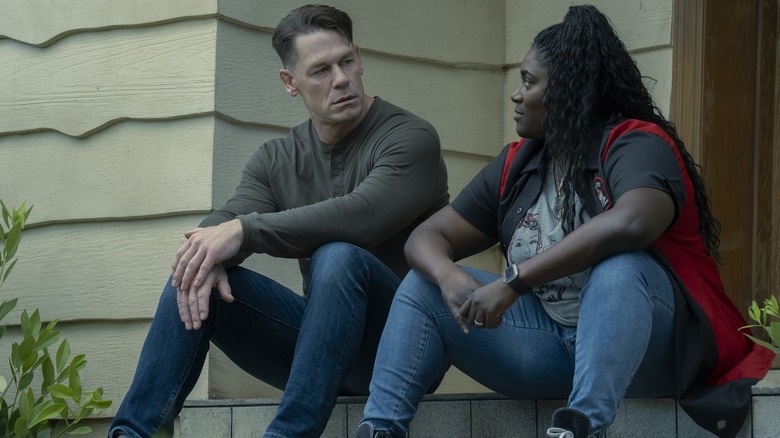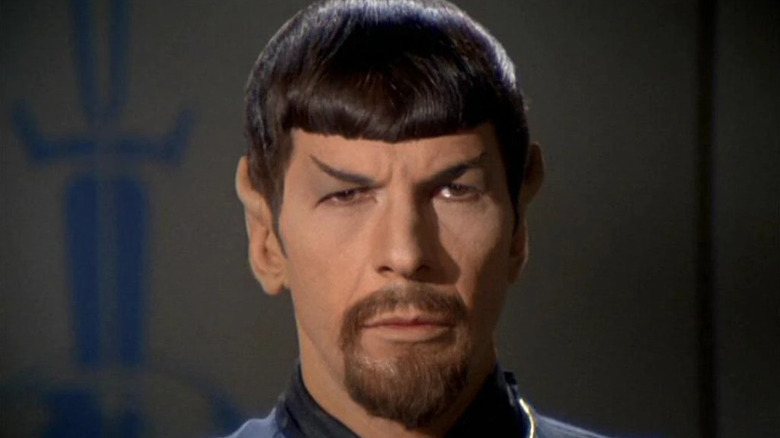Peacemaker Season 2 Beats Marvel At The Multiverse Game By Stealing From Star Trek
Beam us up, Eagly! This article contains spoilers for "Peacemaker" season 2, episode 1, "The Ties That Grind."
With the benefit of hindsight, "Peacemaker" season 2 was probably always going to feature some version of the multiverse. Instead of Zack Snyder's DC Extended Universe, the show's sophomore season takes place in James Gunn and Peter Safran's soft-rebooted DC Universe but still features the same core cast of characters. A parallel universe arc is by far the cleanest storytelling method to achieve this feat, especially since the Marvel Cinematic Universe has spent so much time hardwiring such plot lines into the superhero franchise DNA.
That being said, it's refreshing to see how economically "Peacemaker" season 2 inserts alternate universes (or dimensions, as "The Ties That Grind" calls them) into its story. Where the MCU took several TV shows and movies to introduce its sprawling — and, frankly, somewhat overblown — multiverse, the "Peacemaker" season 2 premiere establishes the DCU version of the same thing in mere minutes by slightly remixing its season 1 recap and repurposing the not-so-dearly departed Auggie Smith's (Robert Patrick) extra-dimensional quantum unfolding storage area into a literal portal to parallel worlds.
The reason "Peacemaker" is able to pull this off so swiftly and easily, of course, is that it can rely on pre-existing pop culture depictions of alternate universes. However, instead of drawing inspiration from the complex timeline tree of the MCU, the show seems to borrow from a far older and more established version of the "many universes" trope. Indeed, the depiction of parallel universes on "Peacemaker" seems to follow the template established by none other than "Star Trek" and its famous Mirror Universe.
The world of Star Trek is full of different dimensions, and Peacemaker is happy to follow its example
The Mirror Universe is a parallel universe that can be accessed through transporter malfunctions and certain other means. It's modeled largely after the franchise's prime universe, with the key difference being that it inverts the moral alignments of every character. Introduced in the "Star Trek: The Original Series" season 2 episode "Mirror, Mirror" in 1967, it's an iconic concept that has given us plenty of enduring images — evil, bearded Spock (Leonard Nimoy), take a bow.
It's safe to say that every fan of genre fiction is at least cursorily familiar with the Mirror Universe, and most are aware of the larger honeycomb of universes, dimensional planes, pocket universes, quantum realities, and Kelvin timelines that "Star Trek" has created over the decades. Sure, it's a touch messy, but the property has nevertheless done decades of heavy lifting to make its take on alternate realities a pop culture benchmark.
Because of the legwork "Star Trek" has already done, viewers will immediately recognize what's going on when Peacemaker (John Cena) finds a strange door that leads him into a new universe populated by polar opposite versions of the people he knows: A nice and friendly Auggie, a decorated and popular superhero version of himself, and even a version of his dead brother Keith (David Denman) who's still alive. To me, it seems that Gunn is establishing the parallel universe concept as economically as he can, relying on the viewer's pre-existing knowledge of Mirror Universe stuff instead of riffing on the MCU or creating yet another overthought take on the multiverse. This is both extremely clever storytelling and a fun homage to "Star Trek," the venerable veteran (and, for my money, reigning champion) of zany multiversal stuff.
The DCU is embracing its own, Star Trek-inspired multiverse
"Peacemaker" season 2 isn't the only DCU project that dives headfirst into a sea of parallel universes. A big plot point in "Superman" is Lex Luthor's (Nicholas Hoult) pocket universe, which the villain uses as a prison, a secure travel method, and a doomsday device all rolled in one. The "Peacemaker" season 2 premiere addresses this as the event that has clued the authorities in on the parallel universe game. Rick Flag (Frank Grillo) and Sasha Bordeaux (Sol Rodriguez) note that the "Luthor Incident's" energy signature even resembles the activation of Peacemaker's quantum storage area, thus bringing these different mini-universes under the same alternate dimension umbrella.
Again, it's a "Star Trek" concept: As mentioned, the sci-fi franchise is happy to embrace a variety of multiversal weirdness as the plot requires. It's a great approach for the DCU, too, allowing for lightning-fast communication of complex concepts. Just watch as the "Peacemaker" season 2 premiere rolls out a thoroughly fed-up "kyphotic alien" (Dorian Kingi), who has his own entrance to the quantum unfolding storage area and seems to use it as a mundane waste disposal area on a regular basis. This is an easy, speedy confirmation that there are lots of strange worlds out there ... and judging by the "Peacemaker" season 2 trailer, some of them are home to giant, screaming skull spiders.
The DCU's apparent decision to embrace the "Star Trek" approach (along with every potential dimension out there) creates countless options. Perhaps some of DC's many excellent Elseworlds comics will make their way in the DCU fold, or perhaps Gunn will even end up bringing a parallel universe version of Robert Pattinson's Batman into the DCU. Right now, the worlds are his oyster.
New episodes of "Peacemaker" season 2 begin streaming on HBO Max every Thursday.


